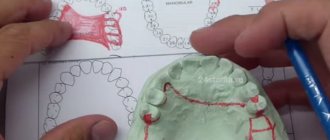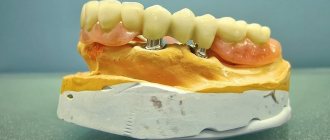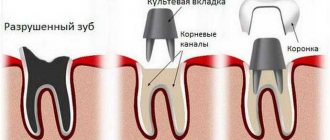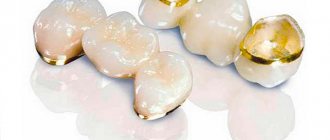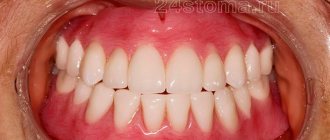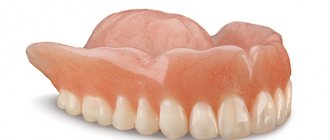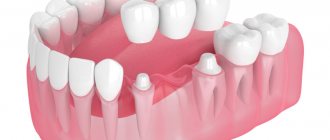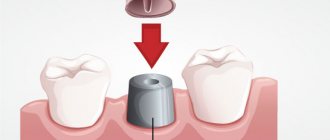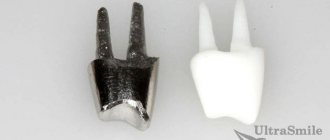- Metal-free ceramics
- Manufacturing technology and installation of ceramic crowns
- Care and service life of ceramic crowns
- Metal-ceramic crowns on teeth
- Manufacturing technology and installation of metal ceramics
- Care and service life of metal ceramics
- What to choose?
In modern dental prosthetics, metal-ceramics and ceramics are among the most popular materials. However, they can hardly be considered interchangeable options - in each specific case the appropriate material is determined individually, because metal-free ceramics and metal ceramics have significant functional and structural differences.
Manufacturing technology and installation of ceramic crowns
Ceramic crowns are manufactured in advanced dental laboratories using modern equipment. After preparing the tooth, impressions are taken of it, which are analyzed by a computer program, and the resulting data is transferred to a high-tech milling machine.
Basic approaches to the manufacture of prostheses:
- Press ceramics, or pressed casting method - in this case, porcelain is applied in layers.
- Computer modeling of all-ceramic prostheses (CAD/CAM technologies).
Advantages and disadvantages of metal-ceramic crowns
The main difference between a zirconium crown and a metal-ceramic crown is the risk of an allergic reaction to alloys made of nickel, chromium-nickel, gold, and other components. The metal oxidizes over time under the influence of saliva, and there is a possibility that a dark border will appear at the base of the prosthesis.
- Versatility - prosthetics of anterior teeth, high-quality restoration of chewing teeth.
- Aesthetics - the difference between metal-ceramic crowns and real teeth is difficult to determine visually, since the shade of the veneer is carefully selected.
- Maintainability - small chips, defects can be eliminated without removing the prosthesis.
- The fit is strong, there is no risk of developing caries due to the penetration of bacteria under the structure, but the fit is inferior in accuracy to zirconium, since the metal is cast and the zirconium crown is milled.
- Increased strength.
- High biocompatibility.
The disadvantages of metal-ceramic crowns include the need for significant grinding of teeth before installation. Prosthetics are not recommended if the teeth are severely damaged.
Care and service life
If we are talking about solid-cast ceramics (and not ceramics with a frame made of zirconium dioxide or aluminum oxide), its strength is still inferior to a metal-ceramic product. The service life is determined to be 5-8 years, subject to proper care and compliance with doctor’s recommendations.
It is important to brush your teeth regularly, avoid using floss (or use it very carefully) to avoid “removing” the crown, and do not forget about the need for professional cleaning every 3-4 months.
Which is better, metal-ceramics or metal-plastic?
Sooner or later, a person faces the question of choosing a material for a dental crown. As a rule, dentists suggest deciding between metal-ceramics and metal-plastic. What to choose? In order not to make a mistake, you need to familiarize yourself with the characteristics of each material in advance and find out the existing pros and cons.
Metal-ceramic crowns
A metal-ceramic crown is a product made of two parts: a metal frame and a ceramic imitation of a tooth. The metal frame is made by casting. There are plenty of advantages to metal-ceramic crowns. Thus, the products have an aesthetically attractive appearance and are highly durable. This combination makes metal-ceramic dental crowns very popular.
The metal-ceramic crown is reliable and strong. Its high strength is ensured by a cast metal frame made of a special alloy and ceramics, which is resistant to abrasion. Such a crown can only be damaged by strong mechanical impact.
The dentist who installs the crown matches its shade to the color of the patient’s teeth so that it does not stand out from the rest. During the entire period of operation, the crown will not darken or lose its color, that is, it will retain its original appearance for a long time. In addition, a metal-ceramic crown does not require complex care. The approximate service life of such products is 10 years.
The disadvantages of metal-ceramic crowns include high price, heavy grinding of the tooth on which the crown is planned to be installed, and removal of pulp from the tooth. Neighboring healthy teeth, which are located next to the metal-ceramic crown, can also suffer from such proximity. From constant contact with the crown during chewing, the teeth may begin to wear out.
There is also a risk of receding gum margins where the crown is placed. Aesthetics may suffer as the metal frame of the crown will be slightly exposed.
Metal-plastic crowns
A metal-plastic crown is a product made of two parts: a metal frame and its plastic covering. Plastic crowns are optimal when urgent tooth repair is required: such products are manufactured very quickly.
Compared to metal-ceramic crowns, plastic crowns are not as durable: their service life does not exceed 3 years. It is for this reason that dentists call metal-plastic products temporary. However, they cost 3 times less than metal-ceramics, which may influence the choice of them.
Plastic crowns have many advantages. So, they are inexpensive, perfectly follow the shape of the tooth, are fixed quickly and firmly, and restore the chewing functions of the tooth. If the product suddenly breaks, the cost of replacement will not cost the patient much, and the work itself will be carried out quite quickly.
Among the disadvantages of metal-plastic crowns, one can note the limited color palette, the metal showing through the plastic part of the crown, and the need to grind the teeth adjacent to the crown. When choosing this option, the patient should keep in mind that the plastic may change its color and darken over time, and it will no longer be possible to lighten it.
Metal-ceramic crowns on teeth
Cobalt-chrome, nickel-chrome are used as a metal frame in modern orthopedics, and the premium class includes ceramic crowns on a gold base.
Conventional metal ceramics have a number of positive qualities:
- strength;
- durability;
- fast production;
- objectively affordable price.
The disadvantages include:
- Inability to install in patients with metal allergies.
- The likelihood of receding gums and the visibility of the lower metal edge (relevant for prosthetics in the frontal area).
Pros and cons of metal-ceramic dental prosthetics
Has the following advantages:
- aesthetics - the design is absolutely no different in appearance from living teeth, harmonizing with them in shape and color (an extensive palette of shades of ceramic coating);
- biological compatibility – indifference to oral tissues, practically does not cause allergies (there is always a percentage of side effects, depending on individual sensitivity);
- functionality – teeth made of metal-ceramics function on a par with natural ones and do not create differences or discomfort;
- durability - durable, withstands chewing loads well, distributes them evenly, which minimizes the risk of chips, cracks, and deformation. Service life is about 10 years or more;
- hygiene – not susceptible to the influence of bacteria and microorganisms;
- color fastness - not colored by any food coloring, which eliminates restrictions on food and drinks;
- tooth protection – fits tightly to the surface, preventing further destruction.
- depulping and turning - installation requires removal of dental nerves and partial removal of hard tissues;
- It is possible for the contacting natural teeth to wear down because they are softer.
The main places for installing such dentures are the lateral areas, which bear the chewing load. On the front teeth, structures based on zirconium dioxide are used, which does not shine through the ceramics. Crowns are placed on a partially destroyed tooth. If only the root remains, then a metal-ceramic is installed on the pin, and if one or more teeth are completely missing, a bridge is installed.
It will be most useful to talk about the advantages of this method of dental prosthetics in comparison with other options for materials for crowns.
- Metal ceramics are much stronger than metal-free ceramics. In terms of years of service, we are talking about 8-10 years of “difference.”
- Metal-ceramic crowns are more affordable for patients. Especially when you compare this option with premium materials, such as zirconium dioxide.
- Metal-ceramics are much more aesthetically pleasing than conventional metal prostheses.
Rules of care
No special care is required for metal-ceramic dentures. It is important to follow normal hygiene rules, brush your teeth twice a day, use dental floss and mouthwash. The use of an irrigator is encouraged.
It's best to limit your consumption of hard foods to avoid chipping. But even if this happens, the process of restoring the prosthesis can be simple and quick. One of the advantages of this material is the possibility of repair without removing the structure: if the metal base is not exposed, but a small chip of the ceramic layer occurs, it is restored with composites in the oral cavity.
Dental crowns - materials and installation steps
In dentistry, an artificial dental crown is a protective cap that completely covers the surface of a tooth and copies its shape. Such caps are installed in cases of severe damage to the natural dental crown, when filling can no longer protect it from destruction.
What materials are used when installing a dental crown?
When making dental crowns, the following can be used:
- Stainless steel;
- Gold;
- Plastic;
- Metal ceramics;
- Super thin ceramic.
This list is gradually increasing as the technical side of dentistry improves - new types of materials appear that are successfully used in prosthetics.
Stages of installing dental crowns
But in any case, installing crowns on natural teeth is a rather complex and lengthy process that requires preparation. It includes several stages:
- Taking an impression;
- Making a crown based on it;
- Grinding the tooth (removing the top layer of tissue from it along with the enamel);
- Fitting for crown fitting;
- Fixing it on the tooth is first temporary, necessary for better “grinding in”, then on a permanent basis.
From all of the above, it is clear that when installing a crown, the tooth often suffers serious injuries. Having lost enamel, it becomes completely defenseless against attack by pathogens.
But if there is not much vitality left in it, it has been drilled and filled more than once, then a crown is the only way to prolong its existence, and its installation is completely justified.
In this case, you just need to make sure that the material from which it is made is both strong and thin enough so that there is no need to grind down the tooth to install it. In this regard, stainless steel crowns are the most practical, but they are only suitable for chewing teeth, the outermost ones in a row.
You can get more information about installing crowns on teeth using this link: /stati/189-koronka-na-zub
You can find more information about metal-ceramic crowns at this link.
Ceramic crowns look most natural on teeth. Their teeth are difficult to distinguish from real teeth.
The front teeth should look natural, and plastic and metal-ceramics are most often used to cover them. However, this involves removing too much of the tooth layer, which causes it to become brittle and susceptible to breakage.
The ideal option is veneers and lumineers made of super-thin ceramics, the installation of which does not require grinding. Of course, they are more expensive than metal-ceramics or plastic, but their use will help preserve both the vitality and performance of the tooth for much longer. And if there is a choice, it is wiser to make it in favor of just such crowns. If necessary, it will be possible to repeat their installation several times while preserving the tooth.
But sometimes crowns serve as support for a dental bridge - a structure designed to cover the empty space on the jaw left after an extracted tooth. They are installed behind the teeth located on either side of the hole.
Often these are completely healthy teeth that have to be injured, violating their natural integrity in order to install a single shield. In such a situation, it would be more reasonable to use an implant. With the advent of this technique, dentistry has made a significant step forward, and many patients are far from advanced age. are now freed from the threat of dentures.
Prices for installing dental crowns in our clinic:
| Service | Price |
| Tooth preparation, impression taking, fixation of a solid crown using titanium | 11,000 rub. |
| Preparing the tooth, taking impressions, fixing the solid crown on the implant | 20,000 rub. |
| Tooth preparation, impression taking, fixation of a one-piece crown made of titanium alloys | 23,000 rub. |
| Tooth preparation, impression taking, fixation of a one-piece crown lined with ceramics | 26,000 rub. |
Features of dental implants
The first operation to implant an artificial base under a crown into the jaw was performed about four decades ago, and every year this prosthetic technique becomes more and more popular.
A dental implant resembles a kind of screw, made of a high-quality metal alloy, hypoallergenic and resistant to the aggressive environment of the oral cavity. The lower part of this screw is implanted directly into the bone tissue of the jaw, and a crown similar to those that cover the surface of real teeth is installed on the upper part.
It is shaped exactly like the tooth that is to be replaced by the implant. Thus, the tooth on the implant is no different from natural ones, and there is no need to use neighboring healthy teeth to install it.
When a person is missing, say, one or two front teeth, implantation will be the best option for him. Often, such structures are installed in place of lost outer teeth, if the space to the nearest “native” tooth is large enough. By placing several implants, they can be used as the basis for a bridge structure.
If there are very few teeth left on the jaw, or none at all, then implants will help avoid such a gloomy prospect as an artificial jaw.
After all, no matter what advertising tells us about the super-reliability of glue for attaching removable dentures, it is very sad to get to know both of them at an age far from advanced.
Installing implants, which will become the basis for attaching permanent dentures, will allow you to avoid this unwanted acquaintance, while maintaining normal chewing functions and the natural appearance of the dentition.
But, of course, they also have their drawbacks. First of all, this is a high price - from 20 thousand rubles for one implant, and higher.
Prices for installing implants in our clinic:
| Service | Price |
| Consultation with an implantologist | 1,000 rub. |
| Implantation Friadent XiVE (Germany): opening of the implant with installation of a gum former | 8,000 rub. |
| Implantation MIS (Israel): opening of the implant with installation of a healing abutment | 5,000 rub. |
In addition, their installation is not recommended for everyone: it is strictly contraindicated for older people with serious health problems (osteoporosis, diabetes, cardiovascular problems).
This is due to the fact that the risk during such an operation is quite high, and the result may not only not live up to expectations, but may not even take place if the implant does not take root in the jaw. They will have to put up with traditional types of prosthetics. For those whose age and health condition allow such an operation, it may be the best way out of the situation.
